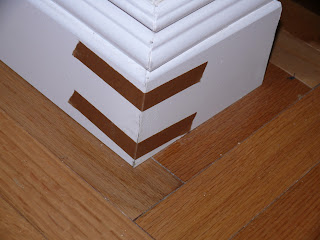 |
| Lots of binding tape to to hold binding in place while it cures. |
Last year I sent a note off to Rob Lee at Lee Valley and
suggested that he should carry an additional product – luthier binding tape.
Myself and many other luthiers use binding tape to hold on pieces of binding
for a guitar body until they dry. Rob checked with one of his staffers who is
also a luthier and it was “oh yea, great stuff, use it for lots of things!”.
 |
| A not so guitar-based use of the tape for home jobs. |
In addition to its intended
use, binding tape has many other uses in the shop and I have used it on many of
the other projects I build. The issue for the non-instrument builder is buying
it from a non-luthier supplier. This was exactly the problem Rob Lee ran into
with trouble finding a supplier for this product. Looks like he made it work!
Now if you look at the first picture of the guitar, that
binding tape is paper based and looks sort of like masking tape, but it is in
fact quite different, and so is the 3M Binding Tape. Normal masking tape fails miserably
in this application; as you apply the tape to the edge of the guitar and use
the tape to pull the binding tight and fasten the tape on the top – regular masking
tape tears or breaks almost every time. Binding Tape on the other hand stays
intact and allows you to use the clamping force of the tape to position and
hold it in place. Many builders use surgical tubing for this step – I have
never been able to make it work for me.
While the tape that Rob found is not what I am used to
buying from the luthier suppliers, it is refreshingly, maybe, just maybe, better. I bought a roll the day they released it on the website.
The tape I am used to using is stiff and very strong, both
good attributes in binding tape, however this 3M tape is both of these things
as well as possessing some elastic properties the others do not. This is a very
good thing, so if you stretch it tight, it actually pulls tighter when you release
it creating an actual clamping effect, better than the holding effect of the
regular stuff.
 |
| 3M Binding Tape in Action! |
Why should you care? This tape is simply indispensable in
the workshop and home improvement arena. It works where clamps do not, around
baseboard corners, closing casing mitres, or for hundreds of different workshop
glue-ups. As in this picture, edging is an excellent application for this tape,
with no clamps needed and the tape does not leave residue on either finished or
raw wood – get yerself some real soon!!









